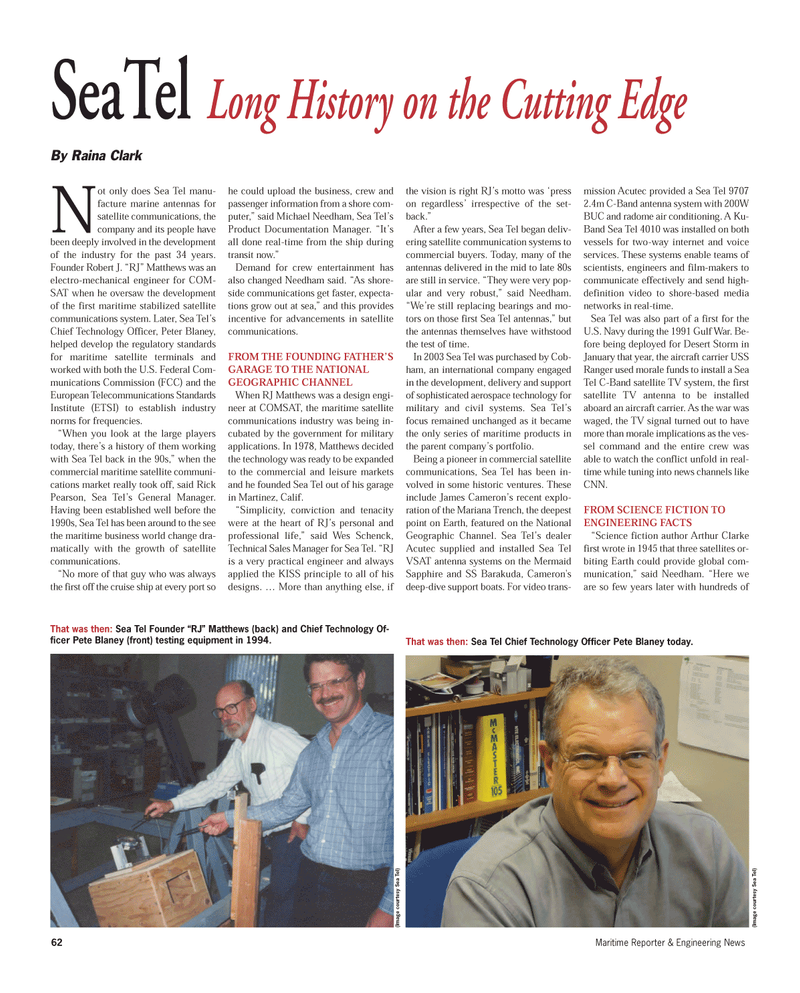
Page 62: of Maritime Reporter Magazine (June 2012)
Annual World Yearbook
Read this page in Pdf, Flash or Html5 edition of June 2012 Maritime Reporter Magazine
62Maritime Reporter & Engineering News Not only does Sea Tel manu- facture marine antennas for satellite communications, thecompany and its people have been deeply involved in the development of the industry for the past 34 years.Founder Robert J. ?RJ? Matthews was an electro-mechanical engineer for COM-SAT when he oversaw the development of the first maritime stabilized satellite communications system. Later, Sea Tel?s Chief Technology Officer, Peter Blaney, helped develop the regulatory standards for maritime satellite terminals andworked with both the U.S. Federal Com- munications Commission (FCC) and theEuropean Telecommunications Standards Institute (ETSI) to establish industrynorms for frequencies.?When you look at the large players today, there?s a history of them working with Sea Tel back in the 90s,? when the commercial maritime satellite communi-cations market really took off, said Rick Pearson, Sea Tel?s General Manager. Having been established well before the 1990s, Sea Tel has been around to the see the maritime business world change dra- matically with the growth of satellite communications.?No more of that guy who was always the first off the cruise ship at every port so he could upload the business, crew and passenger information from a shore com-puter,? said Michael Needham, Sea Tel?s Product Documentation Manager. ?It?s all done real-time from the ship duringtransit now.? Demand for crew entertainment has also changed Needham said. ?As shore- side communications get faster, expecta- tions grow out at sea,? and this provides incentive for advancements in satellite communications.FROM THE FOUNDING FATHER?S GARAGE TO THE NATIONAL GEOGRAPHIC CHANNELWhen RJ Matthews was a design engi- neer at COMSAT, the maritime satellite communications industry was being in- cubated by the government for military applications. In 1978, Matthews decided the technology was ready to be expanded to the commercial and leisure markets and he founded Sea Tel out of his garage in Martinez, Calif. ?Simplicity, conviction and tenacity were at the heart of RJ?s personal and professional life,? said Wes Schenck, Technical Sales Manager for Sea Tel. ?RJ is a very practical engineer and always applied the KISS principle to all of hisdesigns. ? More than anything else, if the vision is right RJ?s motto was ?press on regardless? irrespective of the set- back.? After a few years, Sea Tel began deliv- ering satellite communication systems tocommercial buyers. Today, many of the antennas delivered in the mid to late 80s are still in service. ?They were very pop- ular and very robust,? said Needham. ?We?re still replacing bearings and mo- tors on those first Sea Tel antennas,? but the antennas themselves have withstood the test of time.In 2003 Sea Tel was purchased by Cob- ham, an international company engaged in the development, delivery and support of sophisticated aerospace technology formilitary and civil systems. Sea Tel?s focus remained unchanged as it becamethe only series of maritime products inthe parent company?s portfolio. Being a pioneer in commercial satellitecommunications, Sea Tel has been in- volved in some historic ventures. These include James Cameron?s recent explo- ration of the Mariana Trench, the deepest point on Earth, featured on the NationalGeographic Channel. Sea Tel?s dealer Acutec supplied and installed Sea Tel VSAT antenna systems on the Mermaid Sapphire and SS Barakuda, Cameron'sdeep-dive support boats. For video trans- mission Acutec provided a Sea Tel 9707 2.4m C-Band antenna system with 200WBUC and radome air conditioning. A Ku- Band Sea Tel 4010 was installed on both vessels for two-way internet and voice services. These systems enable teams of scientists, engineers and film-makers to communicate effectively and send high- definition video to shore-based media networks in real-time. Sea Tel was also part of a first for the U.S. Navy during the 1991 Gulf War. Be- fore being deployed for Desert Storm in January that year, the aircraft carrier USS Ranger used morale funds to install a SeaTel C-Band satellite TV system, the first satellite TV antenna to be installed aboard an aircraft carrier. As the war was waged, the TV signal turned out to have more than morale implications as the ves- sel command and the entire crew was able to watch the conflict unfold in real- time while tuning into news channels like CNN.FROM SCIENCE FICTION TO ENGINEERING FACTS ?Science fiction author Arthur Clarke first wrote in 1945 that three satellites or- biting Earth could provide global com- munication,? said Needham. ?Here we are so few years later with hundreds of SeaTel Long History on the Cutting Edge By Raina ClarkThat was then:Sea Tel Founder ?RJ? Matthews (back) and Chief Technology Of- ficer Pete Blaney (front) testing equipment in 1994. (Image courtesy Sea Tel) (Image courtesy Sea Tel) That was then:Sea Tel Chief Technology Officer Pete Blaney today. MR June12 # 8 (57-64):MR Template 6/12/2012 9:10 AM Page 62

 61
61

 63
63
